
Pear rot caused by fungi
Pears can be affected by many different fungi. Here we give an overview of frequently occurring rots caused by fungi.
Overview of pear rot caused by fungi
-
Blue mould. Photo by WFBR Blue mould
Blue mould is caused by the fungus Penicillium expansum. It is a soft watery rot that begins around injuries or lenticels on the skin. Later, greyish blue masses of spores may appear on the pear surface. The decayed tissue has clear edges and easily separates from healthy tissue. Injuries during picking or further handling should be avoided, as these are the primary access points for the fungus. -

Botrytis rot. Photo by WFBR Botrytis rot
Botrytis rot, also called grey mould rot, is (mostly) a soft rot. White-grey mycelium can cover the decayed area that is light brown to brown. The decayed tissue cannot be separated from healthy tissue. The fungus can form large nests of rot in stored fruit. Prevention of infection begins in the orchard. Proper harvesting and handling should limit infections that occur via wounds. -
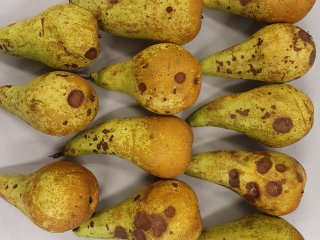
Cadophora. Photo by WFBR Cadophora
Cadophora is a disease which can occur after long storage (more than 6 months) of the pear variety Conference. It is also known as 'fish eye rot'. Once the first symptoms are seen as small spots, it can spread fast to larger and more oval round brown spots. The infection has most likely occurred in the orchard. -
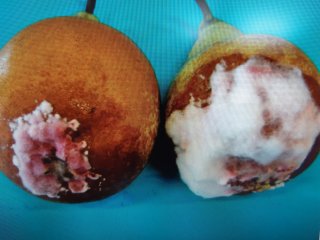
Fusarium. Photo by WFBR Fusarium
Fusarium is a soft rot. Characteristic is the white-yellow-pink mycelium. Most often, the pear's blossom-end or stem-end is affected. The fungus can form nests of rot in stored pears. Fusarium is a so-called wound pathogen. Hence, preventing wounds and damages can reduce the risk of decay. -
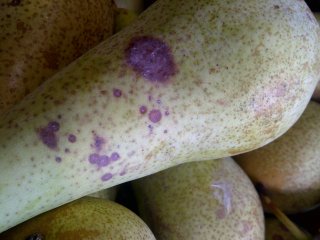
Lenticelspot. Photo by WUR Lenticelspot
Lenticelspot is a postharvest disease caused by the fungus Fibulorhizoctonia. The spots are centered on the lenticels. In later stages, a white mycelium develops and larger rotten spots are formed. The risk is greatest in humid places in the storage room. Therefore, sufficient air circulation through storage bins is recommended. -
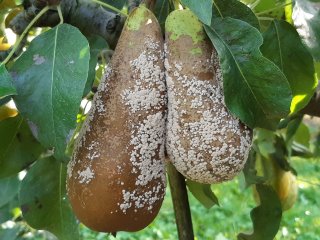
Monilia rot. Photo by WUR Monilia rot
Monilia rot (brown rot) is a firm brown rot which is usually already visible in the orchard. The first indication of infection is a small circular brown spot. Then white mould may appear. During storage, fruits can turn completely black, while the skin remains shiny and unbroken. Prevention of injuries in the skin helps to reduce infection. -
Neofabraea. Photo by WUR Neofabraea
Neofabraea (formerly known as Gloeosporium) forms a circular firm brown rot. It is also known as lenticel rot, and indeed the fungus may attack through a lenticel. The centre of the circle may be lighter coloured than the edge. The disease must be controlled in the orchard. Furthermore, storage conditions that slow down the ripening also slow down the onset of rotting. Consequently, this disease is usually found only after a storage period of at least several months. -
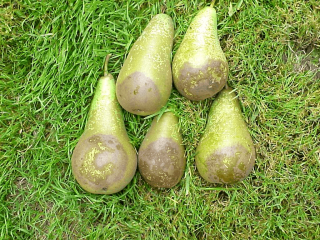
Phytophthora rot. Photo by WUR Phytophthora rot
Phytophthora rot is a firm rot with pale to mid-brown colour. There is no clear boundary between healthy and rotted flesh. The skin can easily detach from the fruit flesh. The pears have an unpleasant odour. The fruits are often originating from low hanging fruit in the orchard (where soil particles splashed up by rain). Also, fruits may have been infected during wet weather around harvest time, or during wet sorting.